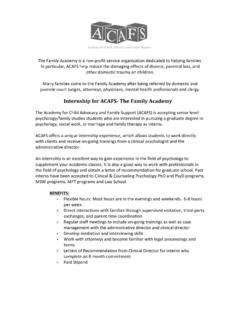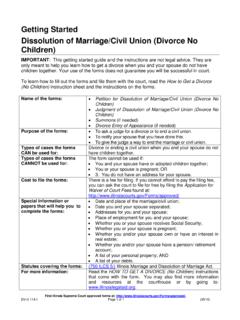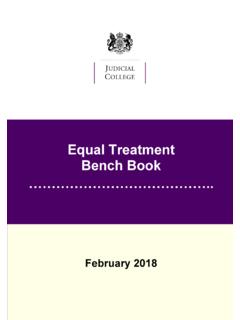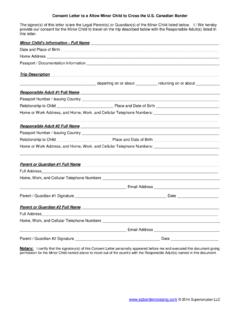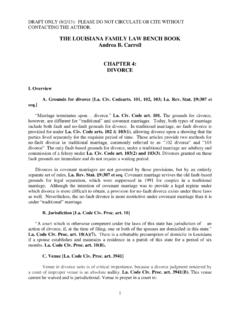Transcription of Valuation Vantage - The McLean Group
1 Effective July 1, 2009, the Financial Accounting Standards Board ( FASB ) rolled out a new clas-sification and organization of its accounting standards, called the Accounting Standards Codifica-tion ( ASC ). The new codification will change GAAP by removing the current four-level GAAP hierarchy and replacing it with two levels: authoritative and non-authoritative. The codification will become the single source of authoritative accounting and reporting stan-dards. Inside This IssueDetermining Reporting Units for Goodwill Impairment TestingConverting to an S Corporation - New Laws and Tax ImplicationsValuator s Cheat Sheet to the New GAAP CodificationSpotlight on Court CasesRecent Valuation Engagements Insights and Perspectives on Leading Corporate Finance Valuation Issues Fall 2009 Valuation Vantage Determining Reporting Units for Goodwill Impairment GAAP requires goodwill impairment testing to be performed at the reporting unit level.
2 As a result, a company s management team, Valuation practitioners, and auditors need to know how many reporting units are within a company and which reporting units hold goodwill. Accounting Standards Code ( ASC ) 350-20-20 defines a reporting unit as an operating segment, or a segment that is one level below an operating segment (also referred to as a component). An operating segment is defined by ASC 280-10-50 as a component of an enterprise that earns rev-enue and incurs expenses, of which discrete financial information is available. Management regularly reviews the operating results of a component to determine the allocation Valuator s Cheat Sheet for the New GAAP CodificationThe McLean Group s Valuation PracticeAs a core competency and complement to its mergers & acquisitions (M&A) practice, The McLean Valuation Service Group provides business Valuation services, including intangible asset and financial security valuations for a variety of transaction, financial reporting, and tax on Investment Bankers to the Middle Market Converting to an S Corporation New Laws and Tax ImplicationsFor many business owners, converting from a C corporation to an S corporation can provide sub-stantial tax savings.
3 Previously, if owners converted from a C corporation to an S corporation, any built-in gains were taxable over a ten year period. Recently, the law has temporarily changed and reduced the recognition period from ten years to seven years. Owners of a C corporation are often taxed twice: the corporation pays tax and the owners pay tax again when dividends are distributed. A similar double taxation can occur when a business is sold. Continued on on the new system will be frustrating for many, the codification will facilitate accounting research. As opposed to researching accounting issues in various places and never being quite sure if you have reviewed each applicable EITF, the codification will make research easier and more complete. All relevant accounting guidance is linked and referenced in one place.
4 We have highlighted the ASC references to the primary valua-tion-related accounting standards below:2 Investment Bankers to the Middle Market Goodwill continued from p. 1of resources among an enterprise s various segments. This task is performed by a chief operating decision maker. Generally, an operating segment also has a segment manager who main-tains regular contact with the chief operating decision maker to discuss operating activities, financial results, forecasts, and plans for the segment. Goodwill impairment testing is not intended to be performed on an acquisition by acquisition basis. For example, the existence of separate legal entities is not relevant. When trying to determine whether or not a specific acquisition is a reporting unit, it is also helpful to analyze qualitative factors.
5 For example, management should consider if the acquisition has its own accounting systems and ledgers and if it has a separate formal budget. Manage-ment should also consider the level that the acquisition has been integrated into the company and how the market perceives the an acquisition, management decides if the acquired entity should remain as a separate reporting unit. Many companies decide to have one reporting unit. The advantage to this is that while one acquired company may be underperforming, another acquired company may be exceeding expectations. Thus, the goodwill that may be impaired from one acquisition could be covered by the other acquisition. w Converting to an continued from p. 1 Conversely, profits and gains from S corporations are passed directly to their shareholders for tax purposes.
6 Shareholders of S corporations report the flow-through of income and losses on their personal tax returns and pay tax at their individual income tax rates. S corporations avoid double taxation on corporate income while maintaining limited liability from creditors. To become an S corporation, a company must meet the follow-ing criteria: Be a domestic corporation; Have only allowable shareholders, which can include individuals and certain trust, and estates, but may not include partnerships, corporations or non-resident alien shareholders; Have no more than 100 shareholders; Have one class of stock; and Not be an ineligible corporation (certain financial insti- tutions, insurance companies, and domestic interna- tional sales corporations are ineligible).One of the drawbacks of converting to an S corporation is the built-in gain tax.
7 The built-in gain tax is a tax on the fair market value of the assets in excess of the tax basis as of the effective date of S corporation, and is only due if these gains are realized within ten years after a company converts. A formal business Valuation is often required to establish the fair market value as of the effec-tive date of the S corporation. A major change to this rule comes from the American Recovery and Reinvestment Act ( ARRA ). Since February 2009, the ARRA has temporarily shortened the ten-year period to seven years for 2009 and 2010. In general, this applies to companies that were sold in 2009 and 2010 and were converted to an S corporation at least seven years prior. Some S corporations may be able to minimize their taxes if they are sold in 2009 or 2010. Business valuations are often required at the time a company converts to an S corporation.
8 Management should consult its tax advisors and legal counsel. w Valuator s Cheat continued from p. 1 Many professionals have spent a career learning the various ac-counting references that will shortly be extinct. The new GAAP references present an opportunity for younger valuators and ac-countants to become fluent with the new references before their older colleagues. All practitioners and analysts need to be fluent in the ASC in order to properly interpret financial statements and research accounting issues. wSFASASCS tock OptionsSFAS 123 RASC 718 Purchase Price AllocationsSFAS 141 RASC 805 Goodwill Impairment TestSFAS 142 ASC 350 Intangible Asset ImpairmentSFAS 144 ASC 360 Fair Value MeasurementsSFAS 157 ASC 820 Trial Court s Minority Discount in 50% Interest RejectedMarriage of Williams, 2009 WL 2597950 (Mont.)
9 (Aug. 25, 2009)A recent trial court ruling was overturned by the Montana Supreme Court because the plaintiff did not adequately justify a 35% minority discount for a 50% interest in a going concern. A father and son (the respondent) equally owned a trucking company, filed as an S-corporation. In addition to the trucking business, the company owned a real estate holding company that invested in five plots of land and two airplane hangars. The two owners equally shared the management responsibilities of the day-to-day op-erations and the divorce trial, the respondent argued that due to his previous misuse of the company s finances, his father terminated his ability to make financial decisions on behalf of the company. Subsequently, the divorce court ruled that the respondent lacked enough control to operate the business without the concurrence of his dad, and implied that his 50% non-controlling interest in the family business is not saleable at face value.
10 Furthermore, the court ruled that the respondent could not require or force the S-corporation to pay out the income on which he is taxed, and to date, the company has paid very little to its owners. The child support awarded in the divorce court excluded the respondent s passive, taxable but not received earnings, and reduced his income to $100,000 per year, despite historical levels ranging from $200,000 to $300,000. The Montana Supreme Court ruled that a discount for a minority interest is appropriate when the minority shareholder has no ability to control salaries, dividends, profit distributions, and day-to-day corporate operations. However, the court found the respondent to have had adequate control over the company s finances and operations, and that his alleged lack of control occurred only after his father took away his power.

